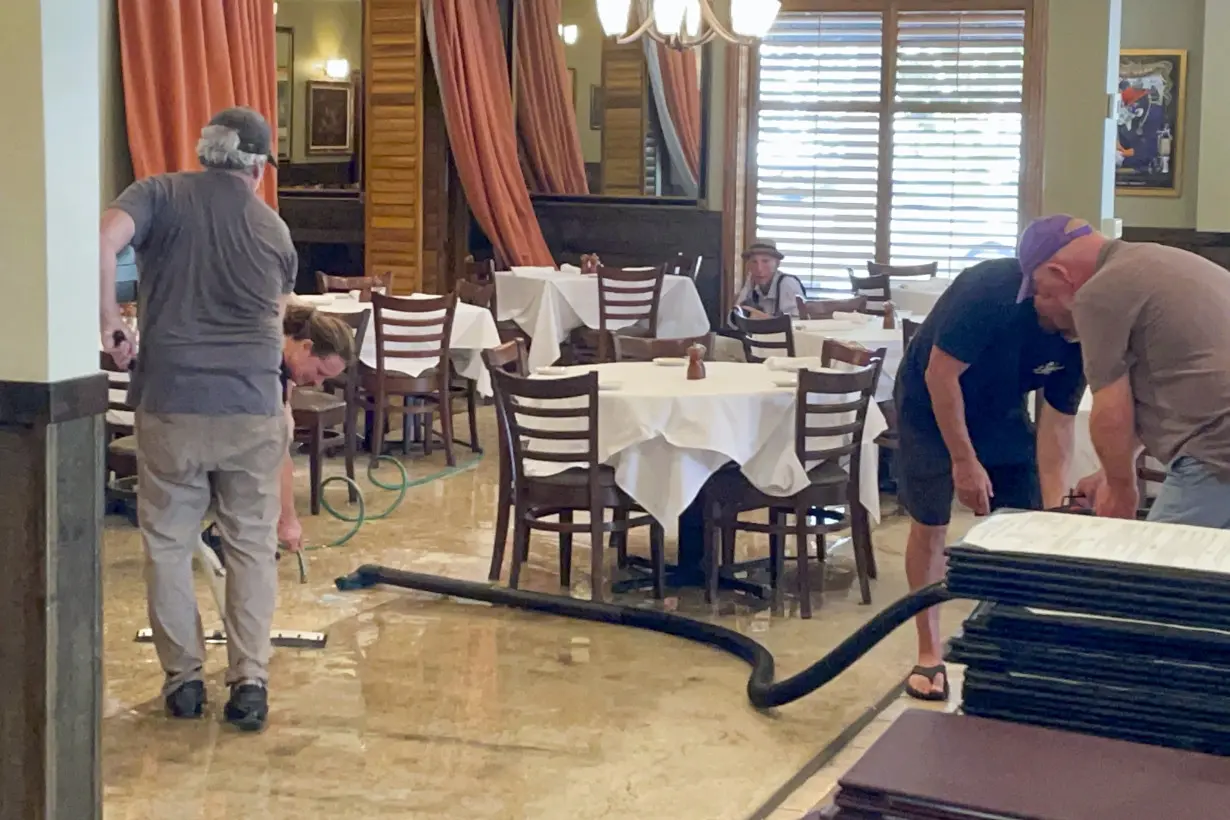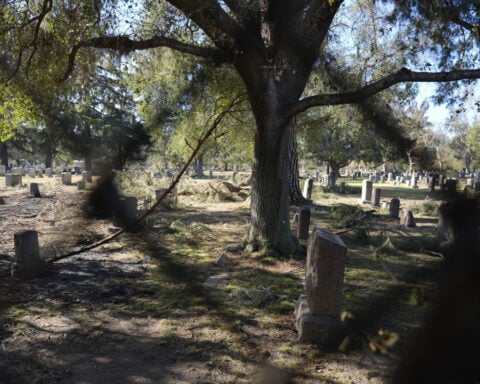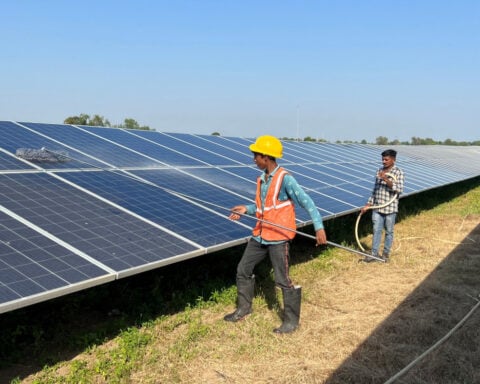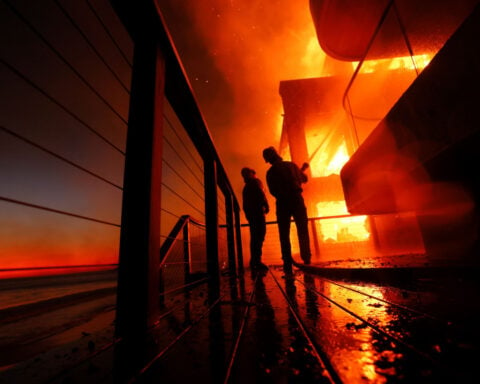NEW ORLEANS (AP) — Hurricane Francine rapidly strengthened before making landfall in Louisiana on Wednesday, knocking out power for hundreds of thousands of people, flooding a cemetery and dumping rain on New Orleans, a city that relies on a uniquely complicated network of canals and pumps to get the water out.
More than 7 inches (18 centimeters) of rain fell in some areas, outpacing its drainage system. Water rose fast in some spots, forcing an emergency room nurse to rescue a pickup truck driver minutes before water covered his vehicle.
“Effectively, the swamp of centuries ago comes back to life, and communities built on those drained lowlands get water in their houses and cars” during bad storms, said Richard Campanella, a professor at Tulane University’s School of Architecture and author of the book “Draining New Orleans.”
New Orleans was shaped by flooding and has long struggled to keep homes dry and the water out. Residents were cautioned to conserve water to reduce stress on the sewer system, although drinking water was never affected. By Thursday, officials said they had emptied out the rain, but that job requires an immense amount of infrastructure vital to keeping New Orleans habitable.

Here is why the city struggles with downpours and how officials fight floodwaters:
Hurricane Katrina showed how bad it can get. A breach in the levy flooded most of the city, stranding residents on rooftops and killing almost 1,400 people. For weeks, pumps worked to drain the flood.
Afterwards, the federal government invested more than $14 billion on a 133-mile massive protection system of levees, pumps and other infrastructure designed to keep the water out. Hurricanes create storm surges that those walls are meant to stop, and Francine didn’t come close to challenging the design. Initial estimates of storm surge at the lakefront of Lake Pontchartrain were about 3 to 5 feet.
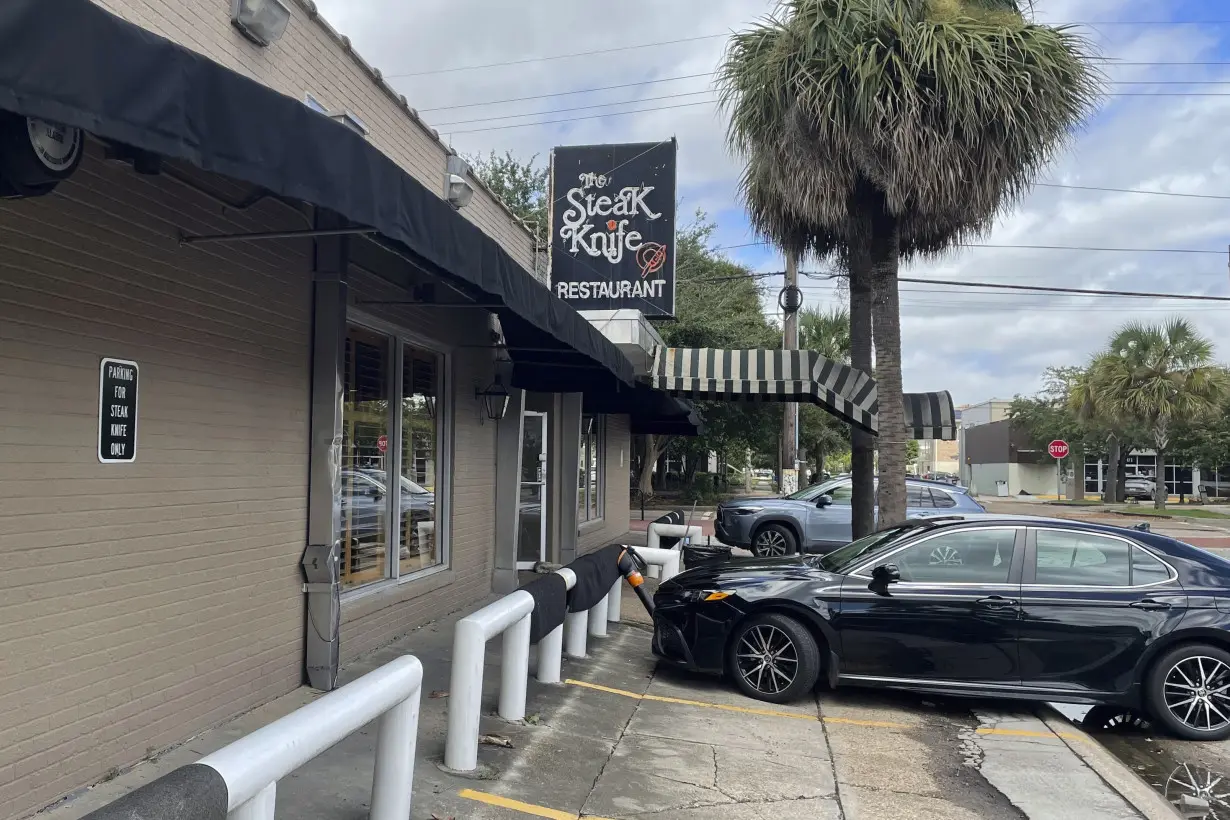
“The walls at that location were about 16 feet. We had a lot more room to go,” said Ricky Boyett, a spokesperson with the Army Corps of Engineers.
But when there is a tight ring of built-up earth, concrete and steel acting as a seal around the city and nearby areas, it keeps rain in, too, and that is a problem.
Simply put, a lot of the city is below sea level. Gravity, which helps most city sewer systems' drain water in nearby wastewater treatment systems, lakes and rivers, is working against it.
That requires moving water uphill, mainly into Lake Pontchartrain to the city's north.
New Orleans rests just up the Mississippi River from Louisiana’s marshy southeastern coast. It is a region shaped by the Mississippi River, which deposited sediment that formed strips of higher ground that are surrounded by dense, swampy lowlands. But building New Orleans meant engineering the river and keeping water out. That stopped the river from depositing new sediment, said Boyce Upholt, author of the book “The Great River: The Making and Unmaking of the Mississippi.”
Now, the city “sinks under its own weight,” he said.
Francine dumped rain inside the city's walls. That is when a complex system of pumps and canals are needed. Generally speaking, the system can drain an inch of water in the first hour and a half-inch each hour after that.
“When a raindrop falls on the city, it goes into catch basins, the catch basin — a minor drainage system — conveys that water into larger pipes or canals and the canals drain that water to those individual pumping stations," said Ghassan Korban, the executive director of the Sewerage and Water Board of New Orleans that manages the drainage system.
When the system backs up, the streets fill first. But homes and businesses can take on water, too, when the system is overwhelmed — as happened in the Lakeview neighborhood when Francine passed over.
Some of the infrastructure the city relies on is old. Some pumps date back as much as a century, although those items have been refurbished over the years.
The infrastructure is enormous — some of the canals can fit a bus. There are 24 drainage pumping stations and 99 major pumps. But the aging pumps run on an outmoded electric frequency, requiring extra equipment to adapt them to modern power generation.
Campanella said reliable power at the correct frequency is one of the system's vulnerabilities.
“Because they are pumps, they need power, and that's where it gets a little dicey,” Korban said.
When Francine arrived, a few pumps had electrical issues, slowing drainage in some places.
The drainage system has undergone various improvements over the years. After severe flooding in 1995, federal projects added new pumping stations and upgraded others while adding miles of canals. A major rainstorm in 2017 sparked significant changes in management at the agency that operates the drainage system. Officials have also constructed ponds to hold stormwater and worked to improve power reliability.
At a post-Francine news conference on Friday in Baton Rouge, Louisiana Gov. Jeff Landry said the drainage system had improved over the years, but there was more work to do. The Republican said state and federal emergency officials are working with the city to determine where pumps and power generation are needed.
“It’s so we can plug rainfall amounts into a model and more accurately predict what those disasters are going to look like and what resources are going to be needed,” Landry said.
A worst-case scenario is when a storm surprises forecasters and stalls over the city, dumping huge amounts of rain. Some of the worst floods the city has seen in recent memory weren't hurricanes, but major rainstorms.
“You just manage the best you can,” Korban said.
And climate change means the atmosphere can hold more moisture, which means the potential for big, wet storms.
“You’ve seen a number of events in Louisiana since Hurricane Katrina that have really challenged the existing storm water infrastructure," said Dominic Boyer, a professor at Rice University in Houston who co-directs Center for Coastal Futures and Adaptive Resilience.
That's “only going to be more challenging as time goes on,” he said.
___
Phillis reported from St. Louis. Associated Press writer Sara Cline contributed from Baton Rouge, Louisiana.
___
The Associated Press receives support from the Walton Family Foundation for coverage of water and environmental policy. The AP is solely responsible for all content. For all of AP’s environmental coverage, visit https://apnews.com/hub/climate-and-environment

 TikTok seeks to reassure U.S. employees ahead of Jan. 19 ban deadline
TikTok seeks to reassure U.S. employees ahead of Jan. 19 ban deadline
 US won't seek charges in unarmed Black motorist Ronald Greene's fatal 2019 arrest
US won't seek charges in unarmed Black motorist Ronald Greene's fatal 2019 arrest
 Euro zone households could increase consumption, ECB chief economist says
Euro zone households could increase consumption, ECB chief economist says
 Foreigners sold South Korean equities last month by most since early 2020
Foreigners sold South Korean equities last month by most since early 2020
 Trump and Biden national and homeland security staff will meet Wednesday for threat exercises
Trump and Biden national and homeland security staff will meet Wednesday for threat exercises
 As fires ravage Los Angeles, Tiger Woods isn't sure what will happen with Riviera tournament
As fires ravage Los Angeles, Tiger Woods isn't sure what will happen with Riviera tournament
 Antetokounmpo gets 50th career triple-double as Bucks win 130-115 to end Kings' 7-game win streak
Antetokounmpo gets 50th career triple-double as Bucks win 130-115 to end Kings' 7-game win streak
 No 97 Laura Siegemund upsets Olympic champion Zheng Qinwen at the Australian Open
No 97 Laura Siegemund upsets Olympic champion Zheng Qinwen at the Australian Open
